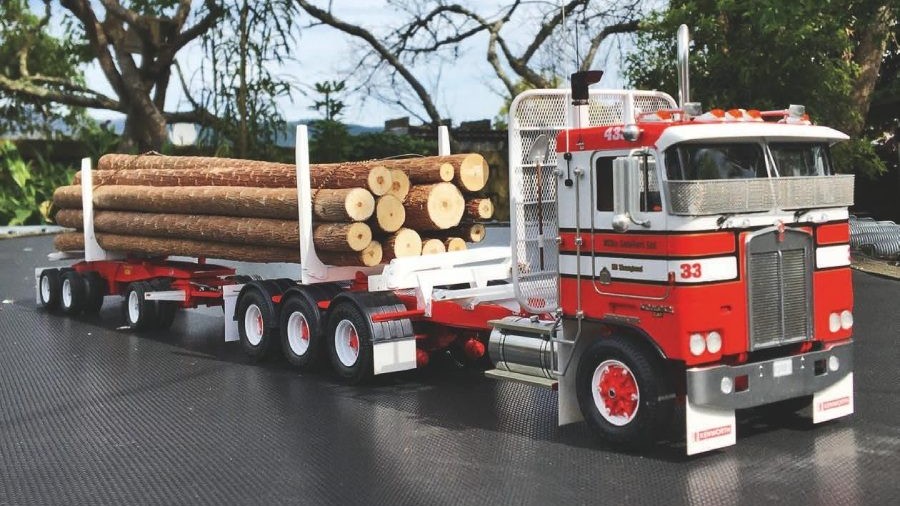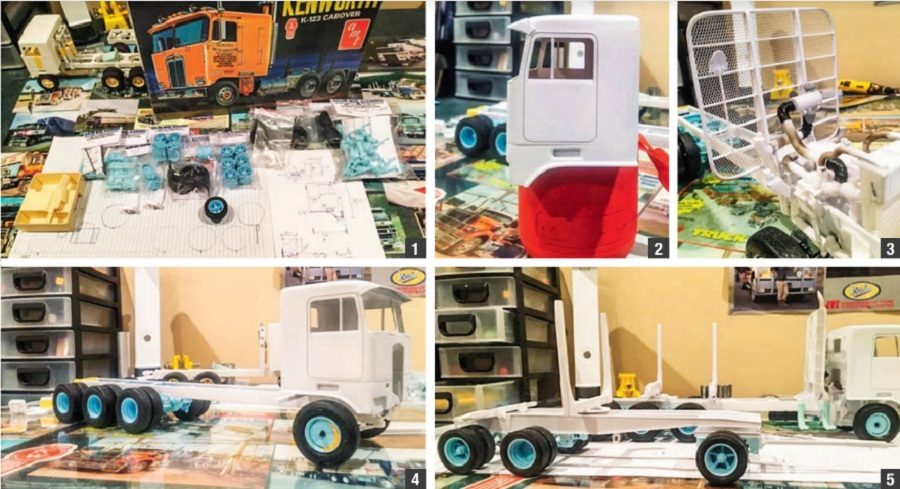
The main test in the November 1993 issue of New Zealand Trucking magazine featured the latest addition to the Papamoa- based Mike Lambert Ltd fleet.
This new steed was something very different for the Bay of Plenty-based logging contractor. Although a tri-drive, a configuration already represented in the fleet via the bonneted T900 Kenworth, this machine was a cabover Kenworth K100E.
It signalled a break away from tradition for the Lambert operation, “known for an almost single-minded adherence to bonneted trucks”, to quote the road
test.

The reason for the shift from the company’s entrenched ethos was the forest industry’s move to harvesting and processing 8.0m logs. Although this cut was no trouble for most trailers at the time, the BBC (bumper to back of cab) measurement of bonneted prime movers meant they could not legally accommodate the new length.
“I don’t like sending my drivers out in a cabover, but if we are going to have to cope with 8.0m logs, this is the only way to do it,” said Mike Lambert at the time.
The pilot of the test truck, Fred Downs, was extremely complimentary of his new charge, with comments such as: “The ride is brilliant, the traction is brilliant, the retardation is brilliant, and as for operating at 55 to 60 tonne on the off-highway roads, she just loves it.”


This first tri-drive K100E Kenworth in Mike Lambert livery was also quick to leave a lasting impression with truck and transport enthusiasts of all ages, none more so than a young Marty Crooks in Wellington.
The fact that it was a cabover Kenwort in the distinctive red, white, and black, the tri-drive bogie set under the rear end, plus the in-house built trailer and convertible log gear, made this an intriguing build that captured his imagination.
 Neither did his intrigue or interest in the unit wane over the years, because 28 years later, we feature Marty’s ‘tip of the hat’ to an iconic logging truck of the era, in model form, as only he can do it.
Neither did his intrigue or interest in the unit wane over the years, because 28 years later, we feature Marty’s ‘tip of the hat’ to an iconic logging truck of the era, in model form, as only he can do it.
The first thing we need to understand is that no off- the-shelf kitset of a K100E Kenworth exists, so the
starting point for Marty was an AMT kit based on an early left-hand-drive sleeper- cabbed K123 Kenworth tractor unit.
The only parts used from this early AMT kit were the shell of the cab and the front springs. Marty first modified the cab to resemble the later-model K100E, reducing it to a day cab, as well as an entirely new roof turret, sun visor, lower-front headlight panels, and grille all from Evergreen sheet styrene plastic.
Inside the cab, a floor pan from aftermarket custom model truck parts manufacturer Auslowe was modified to fit, with the distinctive tall K100E wraparound dashboard being scratch-built by Marty. As for the new door panels and overhead console, these were also handmade.
The seats and deep-buttoned interior linings were scavenged from a Monogram Snap-Tite W-model Kenworth kitset, and then made to fit the K100Ebuild.
The chassis and cross members are a one-off Marty special, all made again from Evergreen sheet styrene
plastic products.

Marty says it is all in the planning, “I draw the whole thing up to scale on paper first to get everything right and in proportion. It’s easier to rub things out on paper rather than having to re-build.”
Measuring a lifesize K100E and taking plenty of reference photos for this build was key to ensuring Marty had all the information he needed to specifications printed in the main test back in November 1993 were also a big help for the wheelbase measurements and other technical information.

The tri-drive axle set and AirGlide suspension were all purchased from Auslowe, as well as the trailer suspension and artillery wheels which fit this build perfectly. The artillery wheels casts are the result of meticulous handcrafting by the team at Auslowe, with the end product cast in resin.
The front axle has operational steering rather than static to add another touch of realism. Sitting above the front axle between the chassis rails, Marty has fitted a heavily modified Caterpillar
3406C, again picked out of the donor Monogram Snap- Tite W-model Kenworth kit.

Hand-crafted are the correct air intake, exhaust systems, and plumbing, with the air cleaner mounted to the headache rack exactly as found on the real rig.
When constructing the trailer and logging equipment, another layer of difficulty was realised as this logging rig was an in-house build.
For Marty, this meant a lot of homework studying countless photographs of the rig, and talking to many of the drivers who used to operate the units, grabbing as much detail as possible to assist with the build.
Various profiles of Evergreen have been utilised to construct the trailer chassis, drawbar and bolster sets. The entire model operates exactly as the real rig did, both as a shorts or longs unit.
The folding bolsters, scratch-built sliding ball race turntablesand hydraulic rams are all operational. The level of detail and accuracy is extraordinary.

Completing the model are the finer details that take it to the next level – genuine handmade and polished
aluminium diesel tanks, airline plumbing to the brake pots, and the chassis- mounted load gauges connected to the airbag plumbing, as were present on the real truck back in the day.
And let’s not forget the towel on the driver’s seat. For Marty, this build hasbeen a labour of love for the past 18 months, the culmination of a journey that started 28 years ago after visiting the real truck with his uncle while on holiday in Taupo.
Countless hours have been spent studying the subject matter throughout the entire construction, and the finished result certainly reflects the level of dedication applied by Marty to this build.






